Neural Control of Voluntary Movements and Sensory Systems
1/134
There's no tags or description
Looks like no tags are added yet.
Name | Mastery | Learn | Test | Matching | Spaced |
|---|
No study sessions yet.
135 Terms
What are the two sets of upper motor neurons?
1. Primary motor cortex and premotor cortex 2. Brainstem centers (reticular formation; vestibular nuclei)
What is the role of upper motor neurons?
They regulate local neural circuits formed by lower motor neurons.
What structures project to the Primary Motor Cortex?
Cerebellum, Basal ganglia, Thalamus (VPC), Thalamus (VA and VL nuclear complex), Somatosensory cortex (area 2), Parietal cortex (sensory regions)
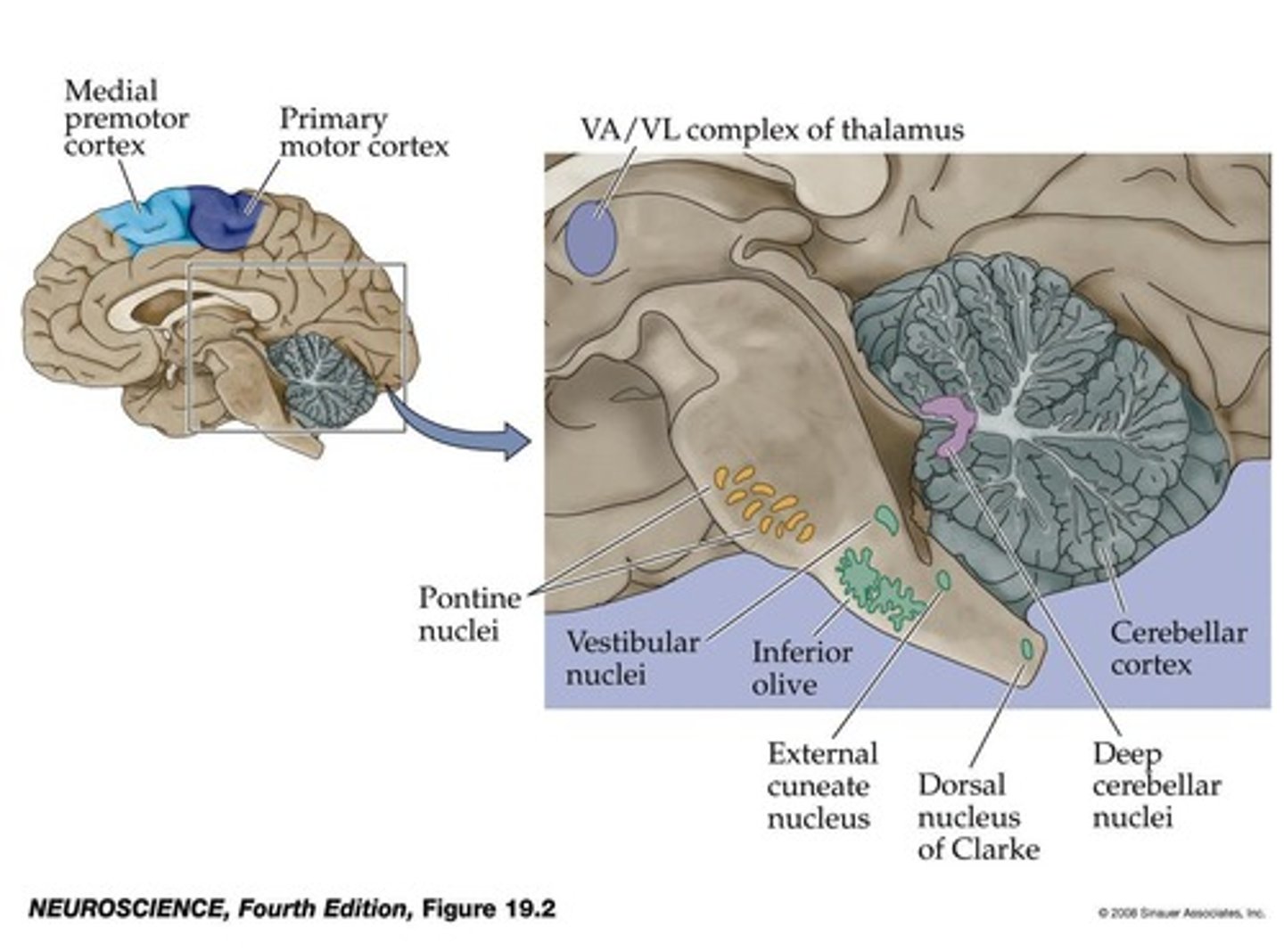
What is the function of the Primary Motor Cortex?
It controls the skilled movements of the limbs and facial musculature, mediating planning, initiation, and direction of complex voluntary movements.
What tracts are involved in projections from the Primary Motor Cortex?
Corticospinal and corticobulbar tracts.
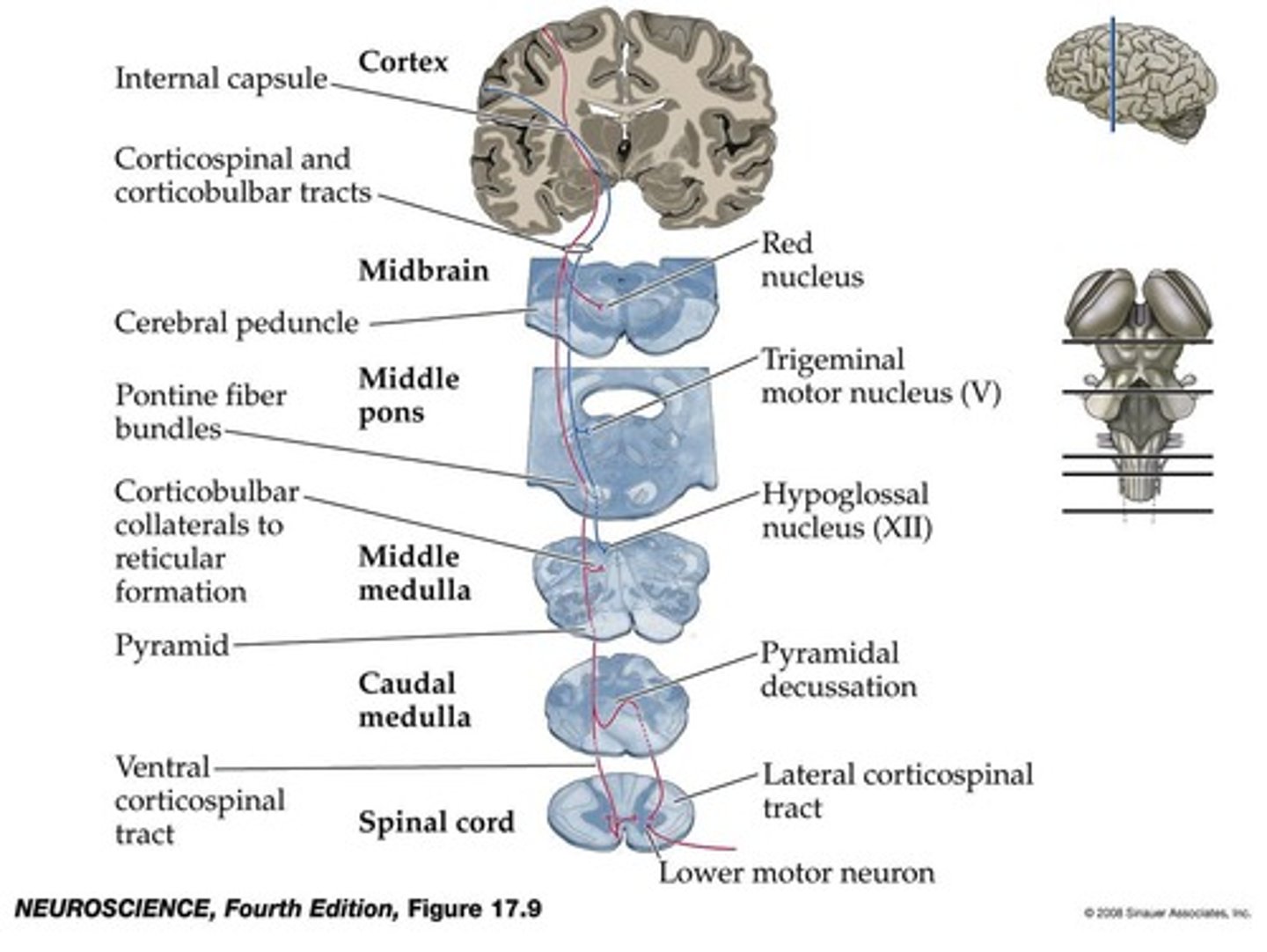
What is the laminar organization of the Primary Motor Cortex?
It consists of 6 cortical cellular layers, with layer 5 containing upper motor neurons.

How are neurons in the motor cortex organized?
They are topographically organized, forming somatotopic maps of body muscles.
What is the significance of the vestibular nuclei in motor control?
They are important for postural adjustments (feedback control) and help prepare the body for adjustments before movements (feedforward control).
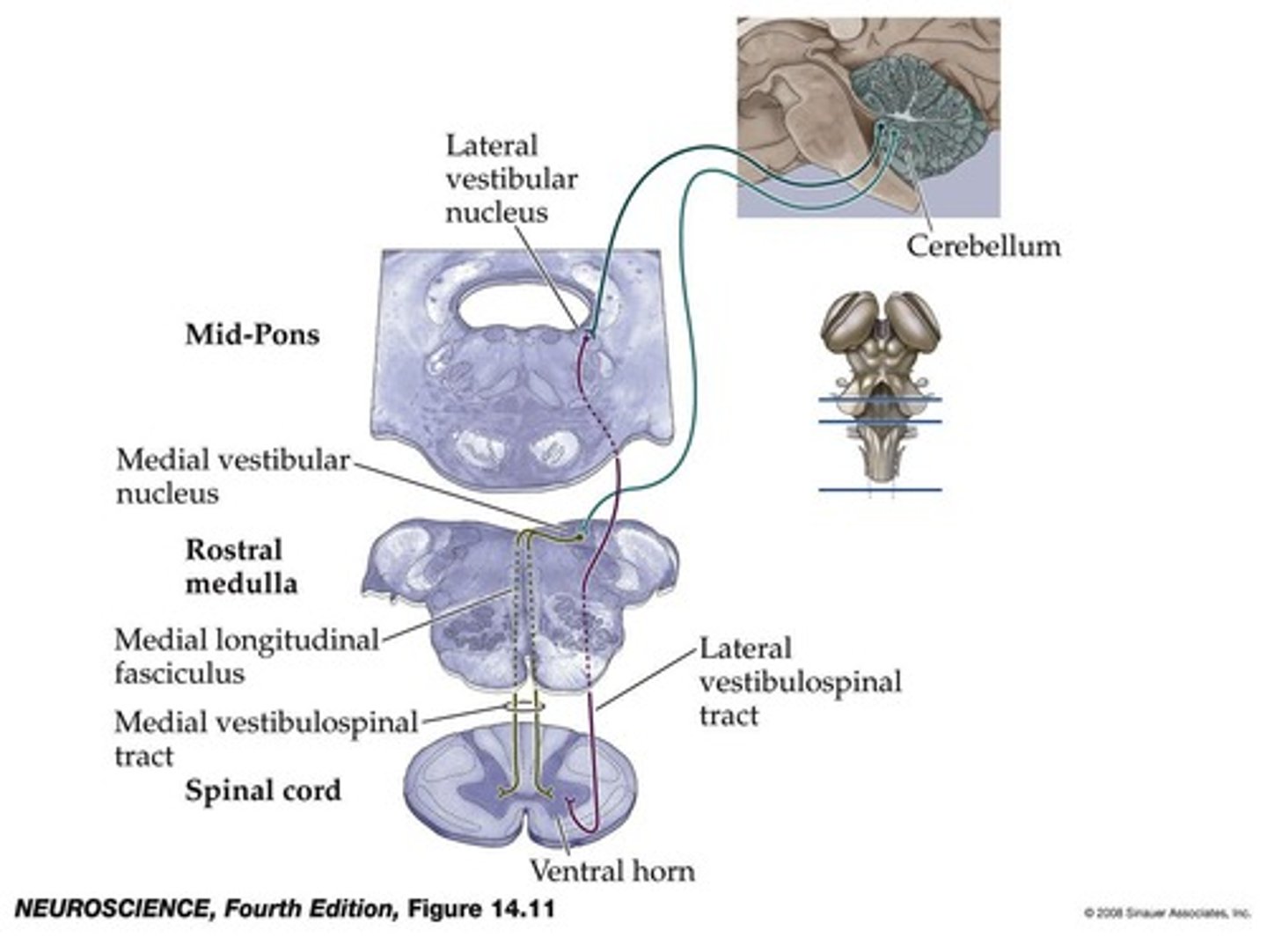
What are the two types of reflexes associated with vestibular nuclei?
Vestibular-cervical reflex (postural adjustments of the head) and Vestibular-spinal reflex (postural adjustments of the body).
What is the role of the reticular formation in motor control?
It integrates inputs from sensory circuits and adjusts the activity of lower motor neurons before movement initiation.
What type of adjustments does the reticular formation facilitate?
Feedforward postural adjustments that accompany voluntary movements.
What is the relationship between the basal ganglia and lower motor neurons?
The basal ganglia do not project directly to lower motor neurons but modulate upper motor neuron activity.

What components make up the motor components of the basal ganglia?
Corpus striatum (caudate and putamen).
How does the cerebellum contribute to motor control?
It plays a major role in feedforward control of voluntary movements by adjusting output to upper motor neurons based on learned errors.
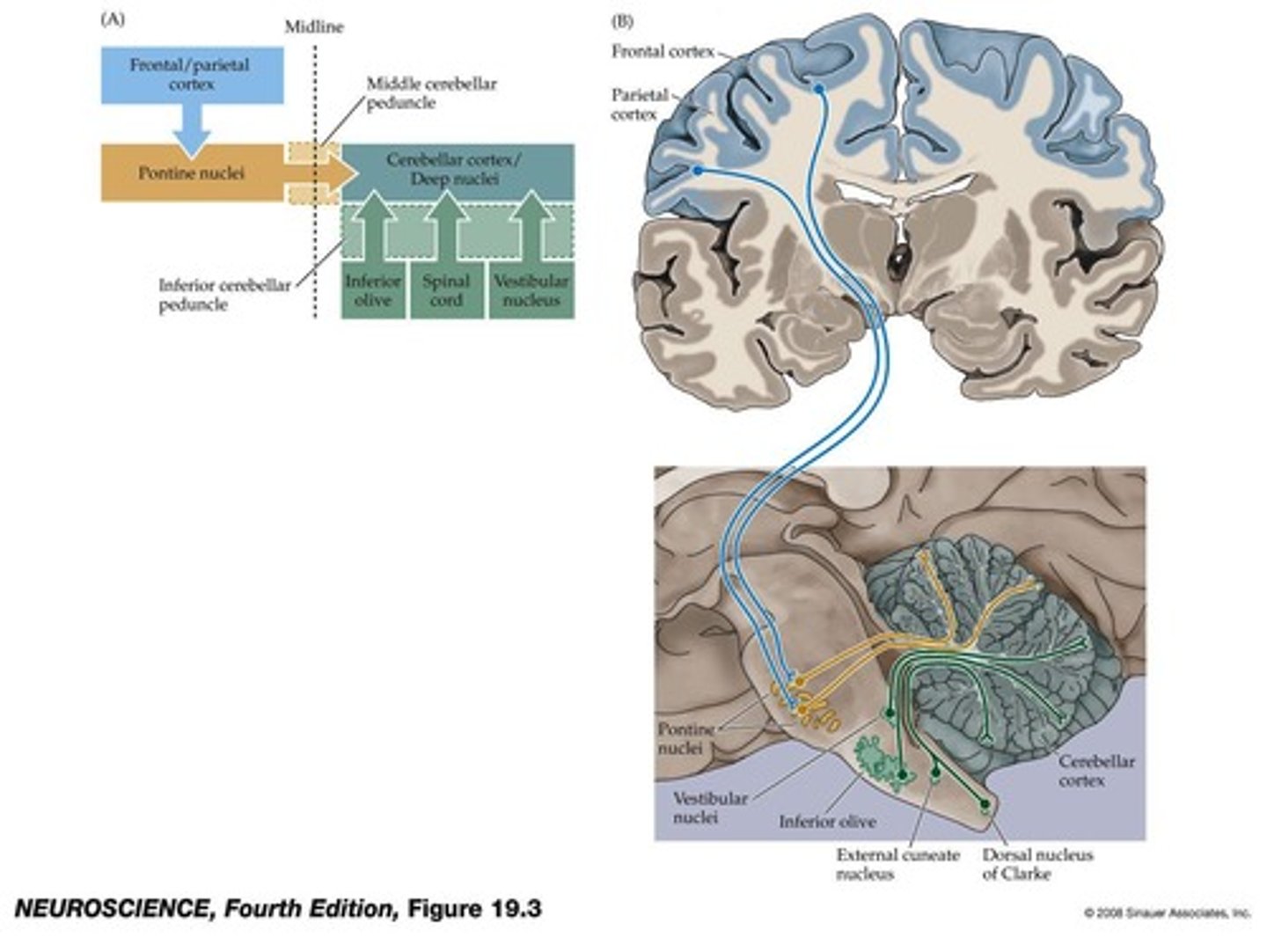
What is the function of the corticospinal tracts?
They convey signals from the cortex to lower motor neurons in the spinal cord.
What is the function of the corticobulbar tracts?
They convey signals from the cortex to lower motor neurons in the brainstem.
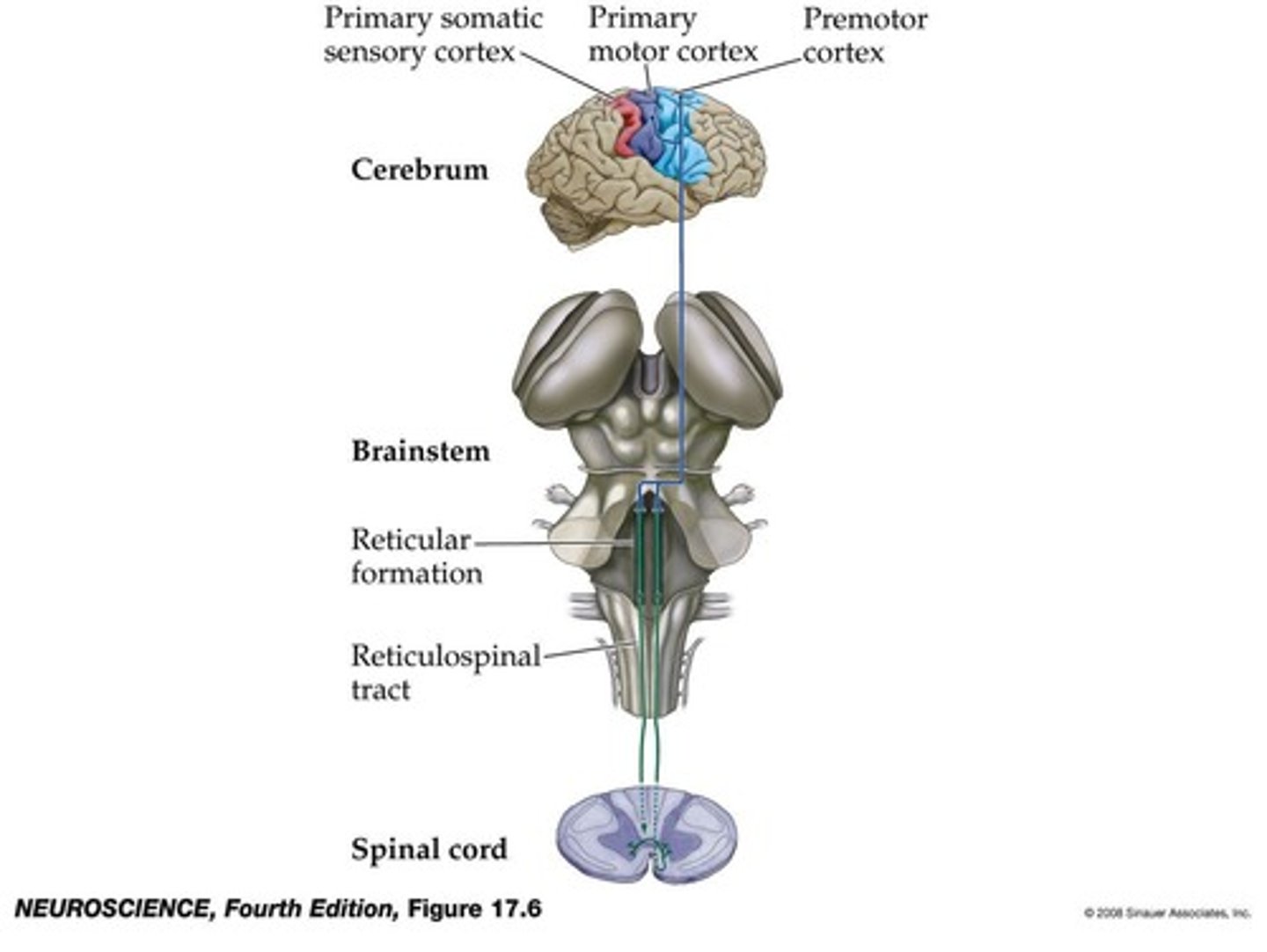
What is the significance of somatotopic maps in the motor cortex?
They represent groups of muscles involved in organized movements rather than individual muscles.
What is the role of the primary motor cortex in movement initiation?
It mediates the planning, initiation, and direction of complex voluntary movements.
What type of control does the reticular formation provide for movements?
Feedforward control for anticipated postural disturbances.
What is the role of the cerebellum in relation to learned errors?
It adjusts the output to upper motor neurons based on learned errors to improve movement accuracy.
What is the function of the primary motor cortex in relation to skilled movements?
It controls skilled movements of the limbs and facial musculature.
What is the importance of local circuits within the Primary Motor Cortex?
They are associated with movements and link neurons within the cortical layers.
What is the overall function of upper motor neurons in the motor system?
They regulate and modulate the activity of lower motor neurons to facilitate voluntary movements.
What are the motor components of the basal ganglia?
Corpus striatum (caudate and putamen) and Pallidum (globus pallidus and substantia nigra pars reticulata).
What is the primary input to the basal ganglia?
Input comes from the primary motor and premotor cortex.
What is the primary output from the basal ganglia?
Output goes to brainstem motor nuclei.
What is the role of the cerebellum in movement?
The cerebellum is essential for motor coordination, control of posture, and balance.
How does the cerebellum provide feedforward control of movements?
It allows for adaptive control that can be adjusted via learning, enabling correction of errors before they happen.
What type of cells provide input to upper motor neurons from the cerebellum?
Purkinje cells provide output from the cerebellar cortex to the deep cerebellar nuclei.
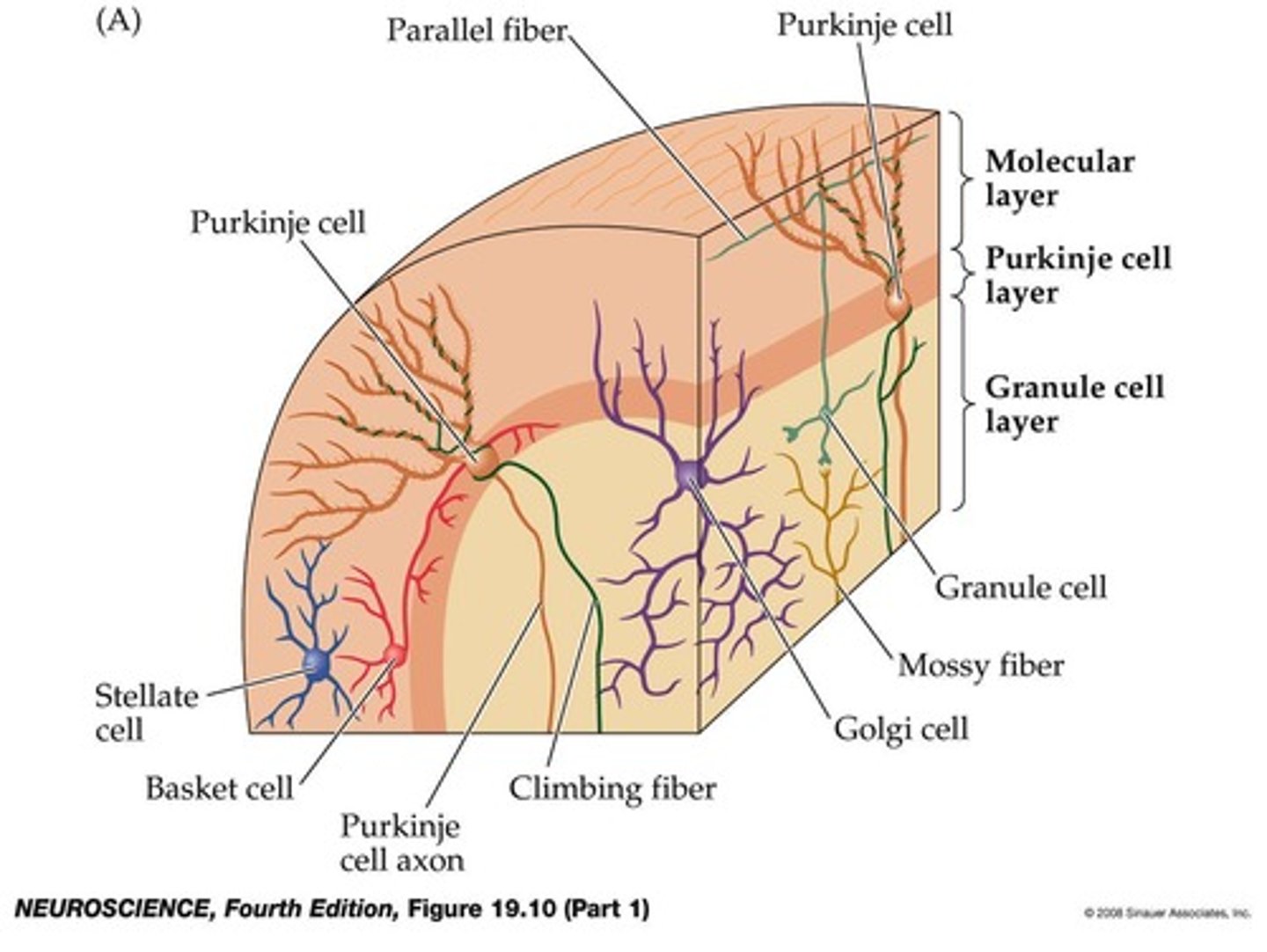
What is the function of climbing fibers in the cerebellum?
Climbing fibers from inferior olive neurons mediate the correction of motor errors by comparing intended with actual movements.
What is the role of Purkinje cells in the cerebellum?
Purkinje cells modulate the activity of deep cerebellar nuclear cells, which is crucial for error correction and smooth movement regulation.
What do complex spikes generated by Purkinje cells indicate?
They strengthen synapses with active parallel fibers, contributing to error correction.
What is the significance of deep cerebellar nuclei neurons?
They provide output to the motor cortex, influencing upper motor neurons.
What types of sensory inputs do deep cerebellar nuclei receive?
Inputs from mossy fibers and climbing fibers collaterals.
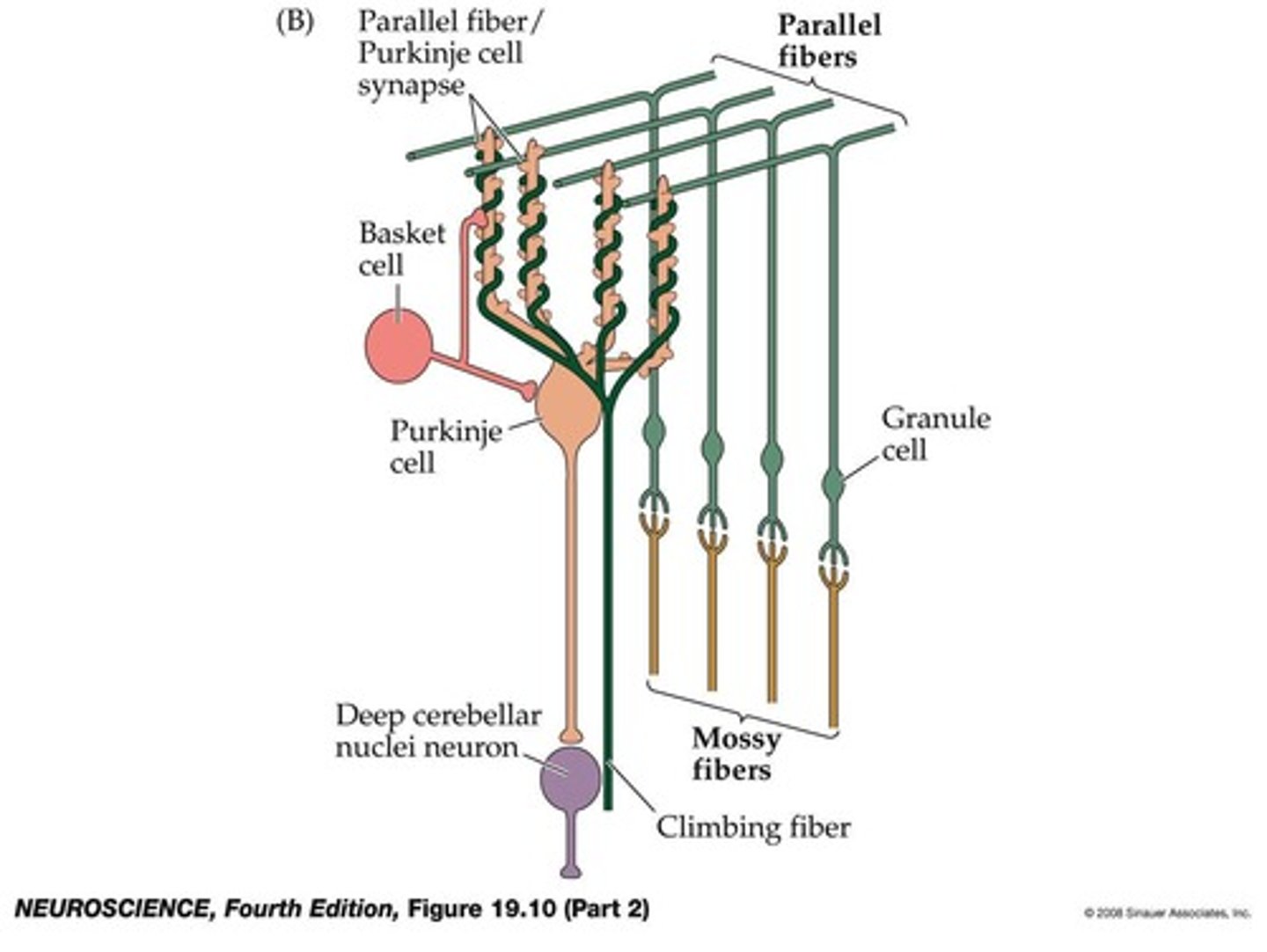
What neurotransmitter is involved in the modulation by Purkinje cells?
GABA.
What is the importance of the error correction circuitry in the cerebellum?
It is required for the regulation of coordinated and smooth movement.
What factors can cause reorganization of topographic maps in the somatic sensory cortex?
Damage to peripheral tissue, extensive use of body parts, and transient local anesthesia.
What indicates that the primary cortex of a sensory system has topographic organization?
It can be divided into areas that receive inputs from different body parts.
Which body surface area has the largest representation in the somatic sensory cortex?
Hands.
What does 'laminar organization' in the primary motor cortex refer to?
Neurons along the radial axis of the cortex have similar orientation preferences.
What is the role of the cerebellar cortex in motor control?
It processes sensory information and adjusts movements based on learned experiences.
How does the cerebellum contribute to posture control?
It coordinates muscle activity to maintain balance and posture.
What is the relationship between the cerebellum and upper motor neurons?
The cerebellum provides input to upper motor neurons in both the primary motor cortex and brainstem centers.
What is the function of the deep cerebellar nuclei?
They integrate inputs from the cerebellar cortex and send output to motor areas.
What is the role of mossy fibers in the cerebellum?
They provide sensory inputs to the cerebellar cortex.
What type of learning does the cerebellum facilitate in movement control?
Adaptive learning that allows for the correction of motor errors.
What is the orientation preference of neurons along the radial axis of the cortex?
They have similar orientation preferences.
What does the cortical surface represent?
It consists of areas that represent organized movements.
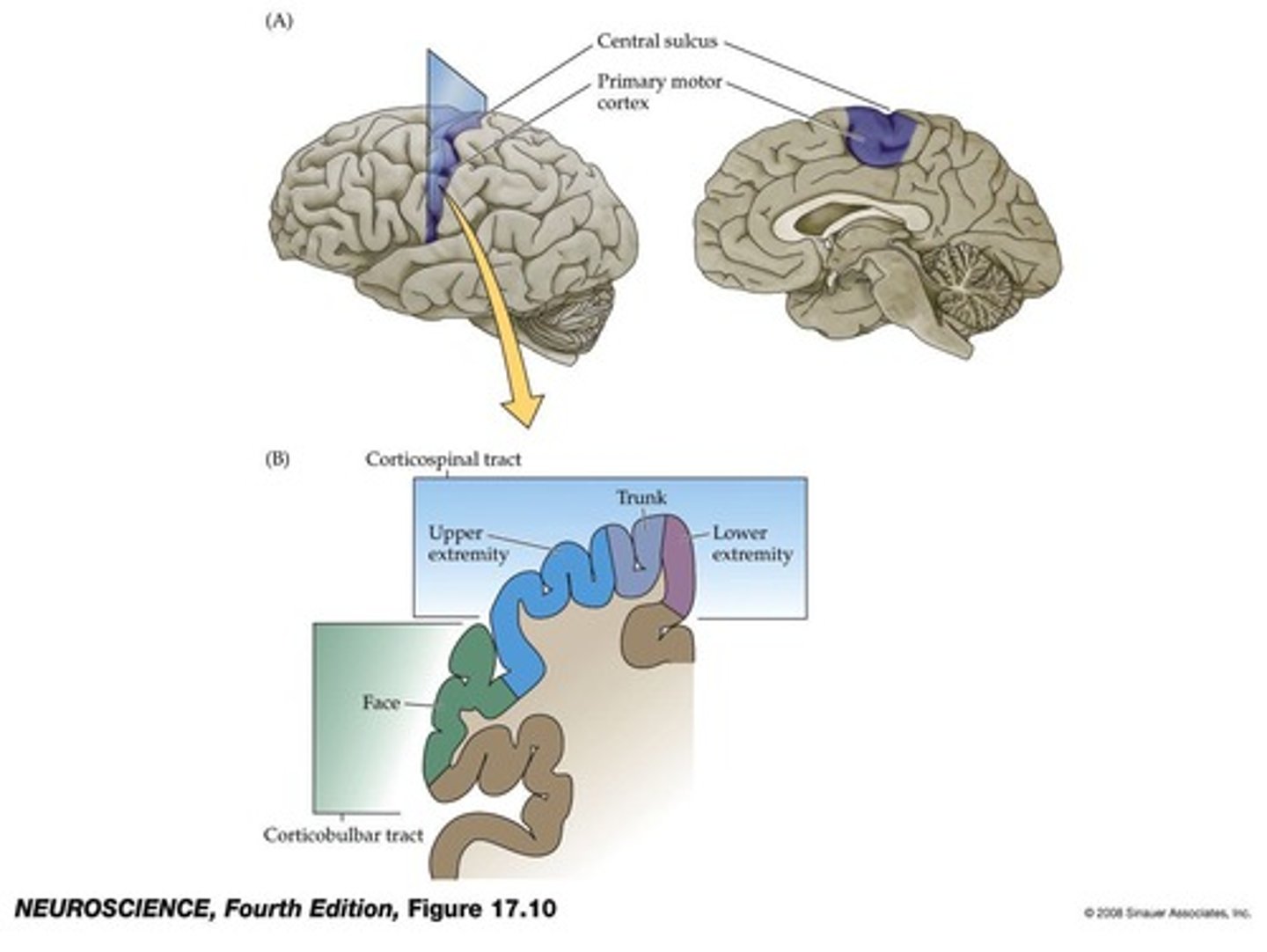
How are cortical neurons organized?
Cortical neurons are organized in layers.
Which sensory signal has the highest conduction velocity in the somatic sensory system?
Changes in the length of the intrafusal muscle fibers.
Are there direct projections from the basal ganglia to lower motor neurons in the spinal cord?
No, basal ganglia neurons do not project directly to lower motor neurons.
What types of sensations does the somatosensory system detect?
It detects sensations from skin, muscles, tendons, and joints.
What are the types of cutaneous sensations?
Touch, pressure, vibration, coarse touch, and painful sensations.
What do nociceptors detect?
Nociceptors detect painful sensations.
What do proprioceptors sense?
They sense muscle stretch, muscle tension, joint position, and over-stretch.
What temperature sensations do temperature sensors detect?
Changes in intermediate temperature, excessive cold (below ~15°C), and excessive heat (above ~43°C).
How does information about painful sensations reach the CNS?
Through signal detection, signal transduction, and signal transmission.
What are the characteristics of free nerve endings?
They are un-myelinated or lightly myelinated small-diameter afferent fibers that detect noxious stimuli.
Why doesn't weak mechanical stimulation cause pain?
The threshold for activating nociceptors is higher than that for cutaneous receptors and proprioceptors.
What channels are responsible for transduction of nociceptive signals?
Cation-permeable ion channels at the membrane of free nerve endings.
What types of stimuli do Ad afferents transmit?
Ad afferents transmit either thermal or mechanical nociceptive stimuli.
What types of stimuli do C fibers transmit?
C fibers transmit thermal, mechanical, and chemical nociceptive stimuli.
How can pain perception be categorized?
Pain can be separated into an early perception (sharp pain) and a later perception (duller pain).
What is the difference in activation thresholds between Ad and C afferents?
Ad afferents have a lower activation threshold and conduct signals with higher velocity compared to C afferents.
What contributes to the difference in perception of pain signals between Ad and C afferents?
Differences in projections in the spinal cord and in neurotransmitters.
What types of receptors are involved in sensing painful temperatures?
Thermo-sensitive receptors that respond to temperature changes.
What is the role of voltage-gated sodium channels in nociceptive afferents?
They are critical for generating action potentials and transmitting nociceptive information.
What is the significance of the spinothalamic tract in pain perception?
It is involved in transmitting pain signals to the brain.
What type of pain do Ad afferents convey compared to C afferents?
Ad afferents convey sharp pain, while C afferents convey duller pain.
What are the differences in projections and neurotransmitters between Ad and C afferents?
These differences may contribute to the variation in perception of conveyed pain signals.
What role do TRPV1 channels play in temperature sensation?
TRPV1 channels at Ad- and C-afferent endings open in response to heat, capsaicin, or endovanilloids, and are active at temperatures above 43°C.
How does capsaicin affect the activation threshold of TRPV1 channels?
Capsaicin binding shifts the activation threshold of TRPV1 channels to lower temperatures, enhancing the perception of heat.
What is the effect of menthol on TRPM8 channels?
Menthol shifts the activation threshold for TRPM8 channels to higher temperatures, resulting in the perception of cold.
What types of neurons are found in the dorsal root ganglion (DRG)?
The DRG contains different types of neurons, including small- and medium-sized nociceptors.
What are the two ascending parallel pathways for pain processing?
1. Sensory-discriminative pathway: Nociceptors → spinothalamic tract → thalamic nuclei → somatosensory cortex. 2. Affective-motivational pathway: Nociceptors → spino-reticular tract → thalamic nuclei → insular cortex, cingulate cortex.
What is the role of the spinothalamic tract?
It mediates discriminative aspects of pain and temperature sensations for the body and face.
How do nociceptive neurons in the primary somatic sensory cortex (S1) contribute to pain processing?
They have small localized receptive fields that support pain localization processing and mediate distinct sensory aspects of pain such as intensity, quality, and duration.
What is the anterolateral system?
The anterolateral system comprises pathways that send pain information to S1, S2, and various brainstem/forebrain regions.
What is visceral nociception and how is it conveyed?
Visceral nociception is conveyed via a dorsal column-medial lemniscal pathway.
What is peripheral sensitization?
Peripheral sensitization is the augmentation of nociceptor activity mediated by substances released from afferent endings and other cells like microphages and mast cells.
What is central sensitization?
Central sensitization is the increase in activity of second-order neurons, which may lead to allodynia, often mediated by NMDARs augmenting glutamatergic transmission.
What are TRPA1 channels and their role in temperature sensation?
TRPA1 channels are activated by innocuous temperatures and contribute to the sensation of normal temperatures.
What is the significance of the thalamic nuclei in pain processing?
Thalamic nuclei serve as relay points for pain information from nociceptors to the somatosensory cortex.
How does pain information remain segregated during processing?
Pain information is processed at the spinal cord level and remains segregated up to the cortical level.
What are the distinct sensory aspects mediated by nociceptive neurons?
Nociceptive neurons mediate aspects such as intensity, quality, and duration of pain.
What is the function of the trigeminothalamic tract?
The trigeminothalamic tract transmits pain and temperature sensations from the face to the thalamic nuclei and somatosensory cortex.
What is the role of second-order neurons in the anterolateral system?
Second-order neurons project to various brainstem and forebrain regions, mediating different sensory and behavioral responses to painful stimuli.
What is the relationship between nociceptors and the somatosensory cortex?
Nociceptors transmit pain signals to the somatosensory cortex, where pain is processed and localized.
What substances mediate peripheral sensitization?
Substances such as neuropeptides and cytokines released from afferent endings and other cells mediate peripheral sensitization.
What is allodynia?
Allodynia is pain induced by innocuous stimuli, often resulting from central sensitization.
What are Ab afferents and their role in pain modulation?
Ab afferents modulate the activity of second-order neurons in the spinal cord via inhibitory interneurons, contributing to the 'gate' theory of pain.
What is the role of descending projections in pain perception?
Descending projections from the somatic sensory cortex, midbrain, and brainstem nuclei modulate the transmission of ascending pain signals.
What sensations does the somatosensory system mediate?
The somatosensory system mediates sensations transduced from skin (cutaneous sensations) and muscle (proprioception), including nociceptive stimuli.
How do nociceptive receptors differ from cutaneous receptors?
Nociceptive receptors (nociceptors) have a higher activation threshold than cutaneous receptors and proprioceptors.
What types of axons convey pain sensations?
Small-diameter lightly myelinated (Ad) or myelin-free (C) axons with free endings convey information about pain sensation.
What channels are involved in the transduction of nociceptive stimuli?
Transient Receptor Potential (TRP) channels are involved in the transduction of nociceptive stimuli.
What are the two parallel pathways for pain processing?
1) Projects to the somatosensory cortex for sensory-discriminative aspects of pain, and 2) Projects to subcortical structures for affective-motivational aspects of pain.
What is peripheral and central sensitization in the context of pain?
Injury can cause peripheral and central sensitization, affecting the transmission of nociceptive signals.
How does the 'gate theory' explain pain modulation?
The 'gate theory' suggests that concurrent non-painful sensory inputs can modulate the transmission of nociceptive signals.
What role do descending projections play in pain modulation?
Descending projections from the somatosensory cortex can activate endogenous opioid release, modulating pain transmission.